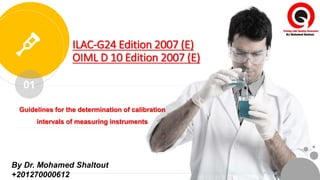
Ilac g24 edition 2007 (e)
- 1. By Dr. Mohamed Shaltout +201270000612 P A G E 01 ILAC-G24 Edition 2007 (E) OIML D 10 Edition 2007 (E) Guidelines for the determination of calibration intervals of measuring instruments
- 2. Introduction
- 3. 6.4.6 Measuring equipment shall be calibrated when: 3 calibration of the equipment is required to establish the metrological traceability of the reported results. The measurement accuracy or measurement uncertainty affects the validity of the reported results, and/or 01 02
- 4. 6.4.7 The laboratory shall establish a calibration programme, which shall be reviewed and adjusted as necessary in order to maintain confidence in the status of calibration.
- 5. ILAC-G24 Edition 2007 (E), OIML D 10Edition 2007 (E) (2) It is also the responsibility of the laboratory to evaluate the effectiveness of the method it chooses to implement. It is the responsibility of each individual laboratory to choose any of calibration methods intervals determination based on its individual needs and its individual assessment of risks (1)
- 6. Distinguish the equipment that it has been calibrated 6 A calibration certificate or calibration label shall not contain any recommendation on the calibration interval, except where this has been agreed with the customer. 6.4.8 7.8.4.3 All equipment requiring calibration or which has a defined period of validity shall be labelled, coded or otherwise identified to allow the user of the equipment to readily identify the status of calibration or period of validity.
- 7. “When to do it” and “How often to do it” “ “
- 8. “When to do it” and “How often to do it” Uncertainty Of Measurement Required Risk Of A Measuring Instrument Exceeding The Limits Cost Of Necessary Correction Measures Methods Used Outside Their Intended Scope Type Of Instrument To be continue,,,,,,,
- 9. “When to do it” and “How often to do it” Tendency To Wear And Drift Manufacturer’s Recommendation; Extent And Severity Of Use Environmental Conditions To be continue,,,,,,,
- 10. “When to do it” and “How often to do it” Recorded History Of Maintenance And Servicing Frequency Of Cross- checking Against Other Reference Standards Or Measuring Devices Frequency And Quality Of Intermediate Checks In The Meantime Transportation Arrangements And Risk
- 11. Methods to determine calibration intervals (1) The Automatic adjustment or “staircase” (calendar-time) (5) Other statistical approaches (4) In service checking, or “black-box” testing non-calendar time) (2) Control chart (calendar- time) (3) “In-use” time (non-calendar time)
- 12. Method 1: Automatic adjustment or “staircase” (calendar-time) Each time an instrument is calibrated on a routine basis, the subsequent interval is extended if it is found to be within e.g., 50 % of the maximum permissible criteria that is required for measurement, or reduced if it is found to be outside this maximum permissible criteria
- 13. Method 1: Automatic adjustment or “staircase” (calendar-time) Advantages 1. This produce used to rapid adjustment of intervals and is easily carried out without rewrite calibration program effort 2. All laboratory equipment will not be stopped until calibration is done simultaneously as before. disadvantage 1. Double effort on the lab to determine the condition of each individual device
- 14. Method 1: Automatic adjustment or “staircase” (calendar-time) disadvantage 2. Treating instruments individually may be that it is difficult to keep the calibration workload smooth and balanced and calibration programme will taken much efforts.
- 15. Method 2: Control chart (calendar-time) 1. Calibration points are chosen and the results are plotted against time. 2. Both dispersion of results and drift are calculated (precision (SD) and accuracy(mean)) 3. The drift (mean) being either the mean of drifts over one calibration interval, or in the case of very stable instruments, the mean of drifts over several intervals 4. Compare the obtained results with manufactures acceptance criteria
- 16. Method 2: Control chart (calendar-time) Advantages 1. Calculation of the dispersion of results will indicate whether the manufacturer’s specification limits are met 2. Analysis of drift found may help in indicating the cause of drift.
- 17. Method 2: Control chart (calendar-time) disadvantage 1. Before use this method, knowledge of the law of variability of the instrument, or similar instruments, is required 2. Difficult to achieve a balanced workload
- 18. Method 3: “In-use” time Calibration interval is expressed in hours of use, rather than calendar months Advantages 1. The advantage of this method is that the number of calibrations performed and therefore the cost of calibration varies directly with the length of time that the instrument is used
- 19. Method 3: “In-use” time Disadvantages 1. The initial cost of the provision and installation of suitable timers is high, and since users may interfere with them 2. Difficult to achieve a smooth flow of work
- 20. Method 4: In service checking, or “black-box” testing 1. Critical parameters are checked frequently (once a day or even more often) by portable calibration gear, or preferably, by a “black box” made up specifically to check the selected parameters 2. If the instrument is found to be outside the maximum permissible error by the “black box”, it is returned for maintenance and full calibration.
- 21. Method 4: In service checking, or “black-box” testing Advantages • Not all laboratory equipment goes out simultaneously for calibration • Continue to monitor the calibration status of the laboratory's instruments Disadvantages • Double effort on laboratory staff
- 22. Method 5: Other statistical approaches 1. Methods based on statistical analysis of an individual instrument or instrument type can also be a possible approach 2. When large numbers of identical instruments (i.e. groups of instruments) are to be calibrated, the calibration intervals can be reviewed with the help of statistical methods
- 23. Method comparison • No one method is ideally suited for the full range of instruments encountered • Method chosen will be affected by whether the laboratory intends to introduce planned maintenance